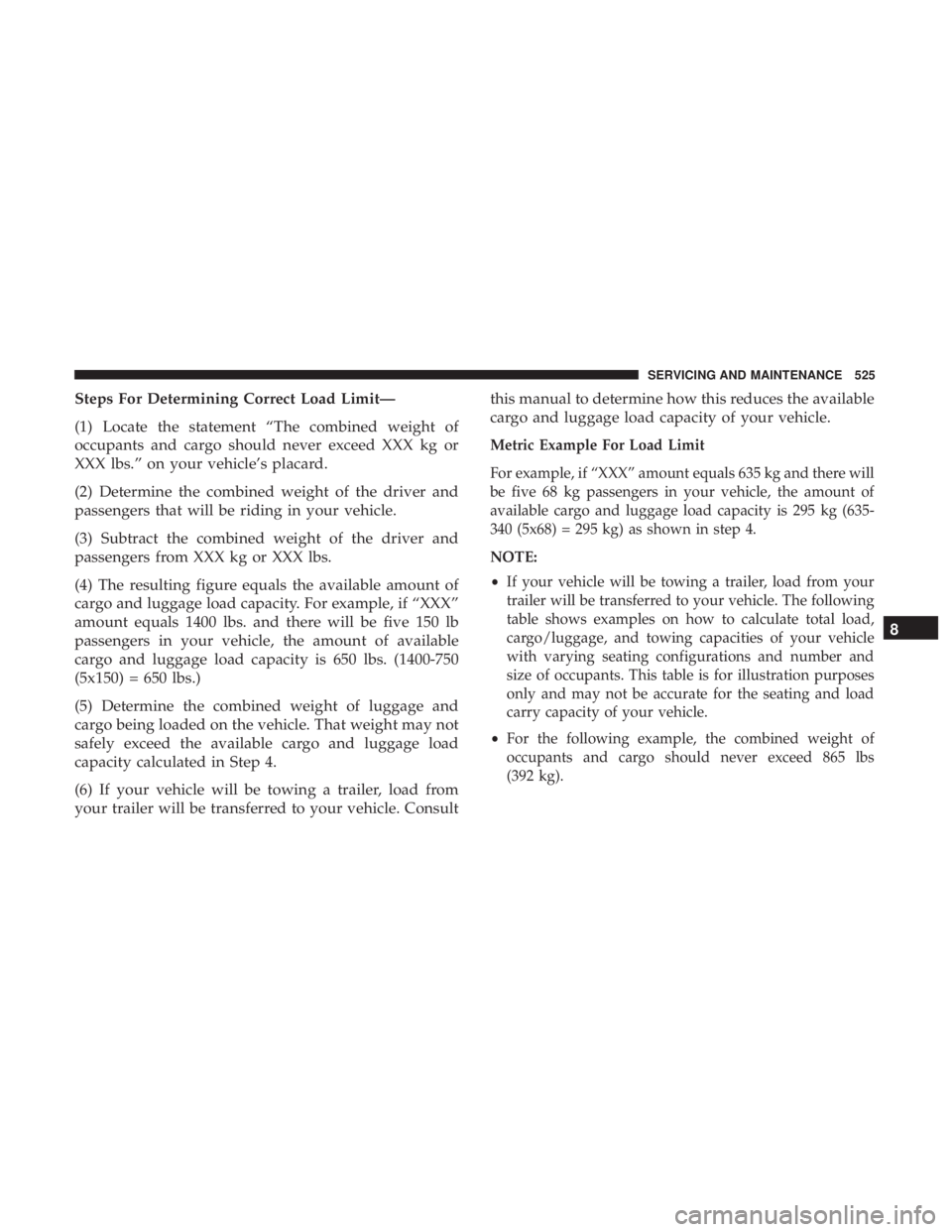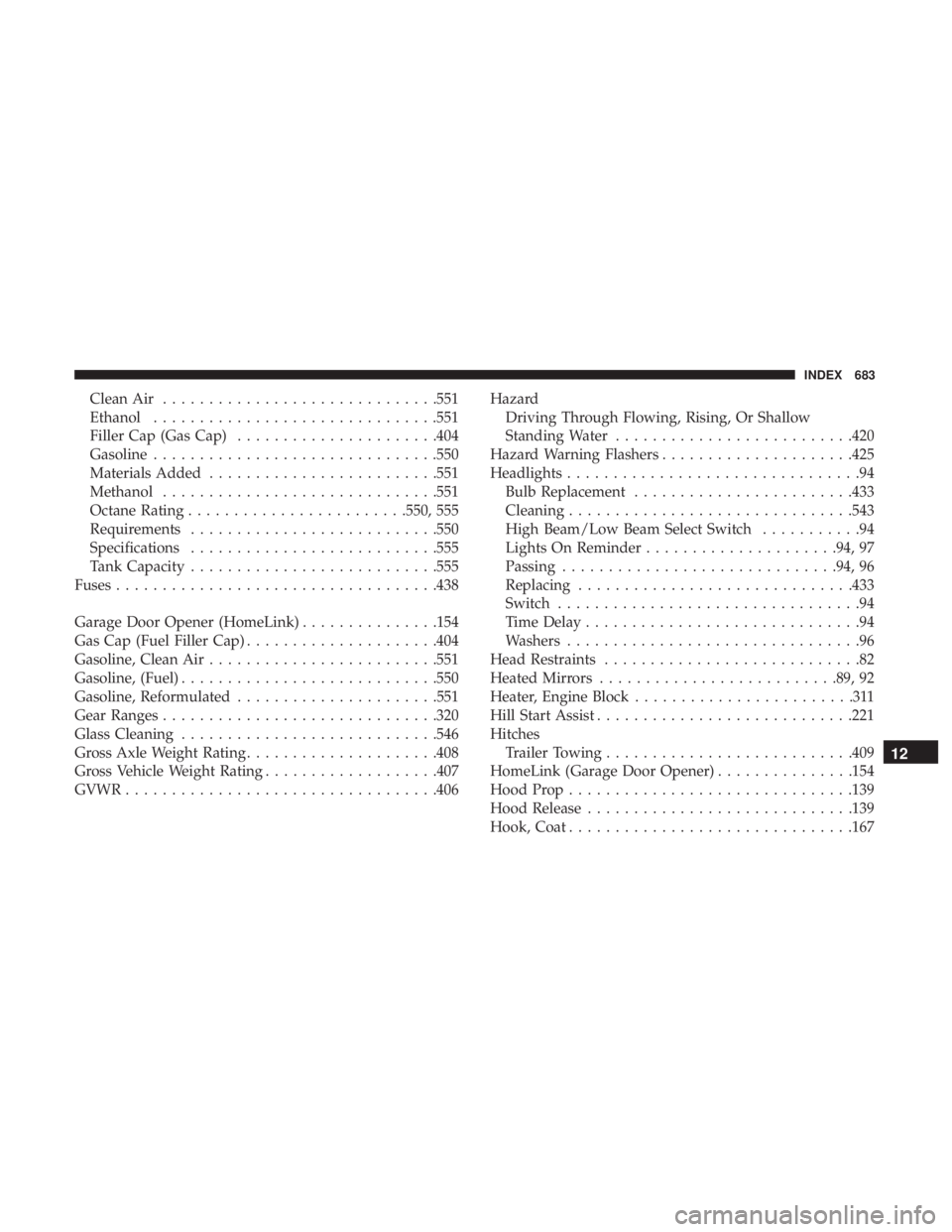2018 CHRYSLER PACIFICA towing capacity
[x] Cancel search: towing capacityPage 417 of 696

•Proper tire inflation pressures are essential to the safe
and satisfactory operation of your vehicle. Refer to
“Tires” in “Servicing And Maintenance” for proper tire
inflation procedures.
• Check the trailer tires for proper tire inflation pressures
before trailer usage.
• Check for signs of tire wear or visible tire damage before
towing a trailer. Refer to “Tires” in “Servicing And
Maintenance” for the proper inspection procedure.
• When replacing tires, refer to “Tires” in “Servicing And
Maintenance” for the proper tire replacement proce-
dures. Replacing tires with a higher load carrying capac-
ity will not increase the vehicle’s GVWR and GAWR
limits.
Towing Requirements — Trailer Brakes
•Do not interconnect the hydraulic brake system or
vacuum system of your vehicle with that of the trailer.
This could cause inadequate braking and possible per-
sonal injury.
• An electronically actuated trailer brake controller is
required when towing a trailer with electronically actu-
ated brakes. When towing a trailer equipped with a hydraulic surge actuated brake system, an electronic
brake controller is not required.
• Trailer brakes are recommended for trailers over
1,000 lbs (453 kg) and required for trailers in excess of
2,000 lbs (907 kg).
WARNING!
•Do not connect trailer brakes to your vehicle’s hy-
draulic brake lines. It can overload your brake sys-
tem and cause it to fail. You might not have brakes
when you need them and could have a collision.
• Towing any trailer will increase your stopping dis-
tance. When towing you should allow for additional
space between your vehicle and the vehicle in front
of you. Failure to do so could result in a collision.
CAUTION!
If the trailer weighs more than 1,000 lbs (453 kg)
loaded, it should have its own brakes and they should
be of adequate capacity. Failure to do this could lead to
accelerated brake lining wear, higher brake pedal
effort, and longer stopping distances.
6
STARTING AND OPERATING 415
Page 526 of 696

Tire And Loading Information Placard
This placard tells you important information about the:
1. Number of people that can be carried in the vehicle.
2. Total weight your vehicle can carry.
3. Tire size designed for your vehicle.
4. Cold tire inflation pressures for the front, rear, and sparetires.Loading
The vehicle maximum load on the tire must not exceed the
load carrying capacity of the tire on your vehicle. You will
not exceed the tire’s load carrying capacity if you adhere to
the loading conditions, tire size, and cold tire inflation
pressures specified on the Tire and Loading Information
placard in “Vehicle Loading” in the “Starting And Operat-
ing” section of this manual.
NOTE: Under a maximum loaded vehicle condition, gross
axle weight ratings (GAWRs) for the front and rear axles
must not be exceeded.
For further information on GAWRs, vehicle loading, and
trailer towing, refer to “Vehicle Loading” in the “Starting
And Operating” section of this manual.
To determine the maximum loading conditions of your
vehicle, locate the statement “The combined weight of
occupants and cargo should never exceed XXX kg or
XXX lbs” on the Tire and Loading Information placard. The
combined weight of occupants, cargo/luggage and trailer
tongue weight (if applicable) should never exceed the
weight referenced here.
Tire And Loading Information Placard
524 SERVICING AND MAINTENANCE
Page 527 of 696

Steps For Determining Correct Load Limit—
(1) Locate the statement “The combined weight of
occupants and cargo should never exceed XXX kg or
XXX lbs.” on your vehicle’s placard.
(2) Determine the combined weight of the driver and
passengers that will be riding in your vehicle.
(3) Subtract the combined weight of the driver and
passengers from XXX kg or XXX lbs.
(4) The resulting figure equals the available amount of
cargo and luggage load capacity. For example, if “XXX”
amount equals 1400 lbs. and there will be five 150 lb
passengers in your vehicle, the amount of available
cargo and luggage load capacity is 650 lbs. (1400-750
(5x150) = 650 lbs.)
(5) Determine the combined weight of luggage and
cargo being loaded on the vehicle. That weight may not
safely exceed the available cargo and luggage load
capacity calculated in Step 4.
(6) If your vehicle will be towing a trailer, load from
your trailer will be transferred to your vehicle. Consultthis manual to determine how this reduces the available
cargo and luggage load capacity of your vehicle.
Metric Example For Load Limit
For example, if “XXX” amount equals 635 kg and there will
be five 68 kg passengers in your vehicle, the amount of
available cargo and luggage load capacity is 295 kg (635-
340 (5x68) = 295 kg) as shown in step 4.
NOTE:
•
If your vehicle will be towing a trailer, load from your
trailer will be transferred to your vehicle. The following
table shows examples on how to calculate total load,
cargo/luggage, and towing capacities of your vehicle
with varying seating configurations and number and
size of occupants. This table is for illustration purposes
only and may not be accurate for the seating and load
carry capacity of your vehicle.
• For the following example, the combined weight of
occupants and cargo should never exceed 865 lbs
(392 kg).
8
SERVICING AND MAINTENANCE 525
Page 685 of 696

Clean Air............................. .551
Ethanol ...............................551
Filler Cap (Gas Cap) ..................... .404
Gasoline ...............................550
Materials Added ........................ .551
Methanol ............................. .551
Octane Rating ........................550, 555
Requirements .......................... .550
Specifications .......................... .555
Tank Capacity .......................... .555
Fuses .................................. .438
Garage Door Opener (HomeLink) ...............154
Gas Cap (Fuel Filler Cap) .....................404
Gasoline, Clean Air ........................ .551
Gasoline, (Fuel) ............................550
Gasoline, Reformulated ..................... .551
Gear Ranges ............................. .320
Glass Cleaning ............................546
Gross Axle Weight Rating .....................408
Gross Vehicle Weight Rating ...................407
GVWR ................................. .406Hazard
Driving Through Flowing, Rising, Or Shallow
Standing Water ..........................420
Hazard Warning Flashers .....................425
Headlights ................................94
Bulb Replacement ........................433
Cleaning ...............................543
High Beam/Low Beam Select Switch ...........94
Lights On Reminder .....................94, 97
Passing ............................. .94, 96
Replacing ............................. .433
Switch .................................94
Time Delay ..............................94
Washers ................................96
Head Restraints ............................82
Heated Mirrors ..........................89, 92
Heater, Engine Block ........................311
Hill Start
Assist ............................221
Hitches Trailer Towing .......................... .409
HomeLink (Garage Door Opener) ...............154
Hood Prop ...............................139
Hood Release ............................ .139
Hook, Coat ...............................167
12
INDEX 683
Page 692 of 696

System, Remote Starting......................28
Telescoping Steering Column ...................87
Temperature Control, Automatic (ATC) ...........130
Tie Down Hooks, Cargo ..................... .146
Tilt Steering Column .........................87
Time Delay Headlight ...............................94
Tire And Loading Information Placard ............523
Tire Markings ............................ .518
Tires......................... .303, 527, 534, 540
Aging (Life Of Tires) ..................... .531
Air Pressure ............................527
Chains ............................... .538
Changing .......................... .446, 517
Compact Spare ..........................535
General Information ...................527, 534
High Speed ............................ .529
Inflation Pressure ........................528
Jacking ........................ .446, 448, 517
Life Of Tires ............................531
Load Capacity .......................523, 524
Pressure Monitoring System (TPMS) . . . .189, 205, 234
Quality Grading ........................ .540
Radial ............................... .529Replacement
............................532
Rotation ...............................539
Safety ............................ .517, 527
Sizes .................................519
Snow Tires ............................ .534
Spare Tires ..................... .447, 534, 536
Spinning ...............................530
Trailer Towing .......................... .414
Tread Wear Indicators .....................531
Wheel Nut Torque ........................549
Tire Safety Information .......................517
Tire Service Kit ............................464
Tongue Weight/Trailer Weight .................413
T o
Open Hood ............................139
Towing ................................. .407
Disabled Vehicle ........................ .482
Guide .................................410
Recreational ............................418
Weight ............................... .410
Towing Vehicle Behind A Motorhome ............418
Traction ............................. .419, 420
Traction Control .......................... .215
Trailer Sway Control (TSC) ....................222
Trailer Towing ............................ .407
Cooling System Tips ..................... .417
690 INDEX